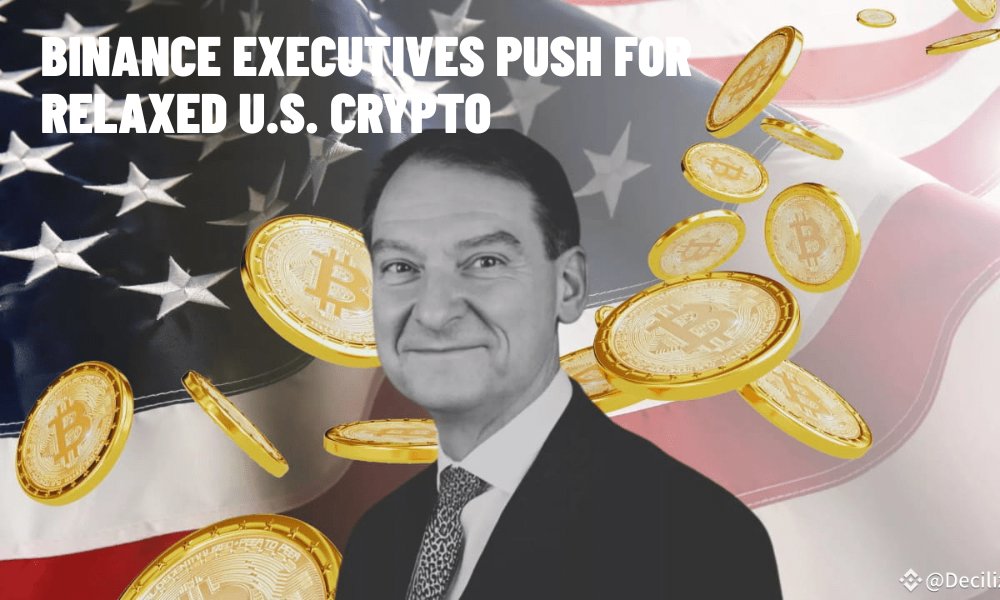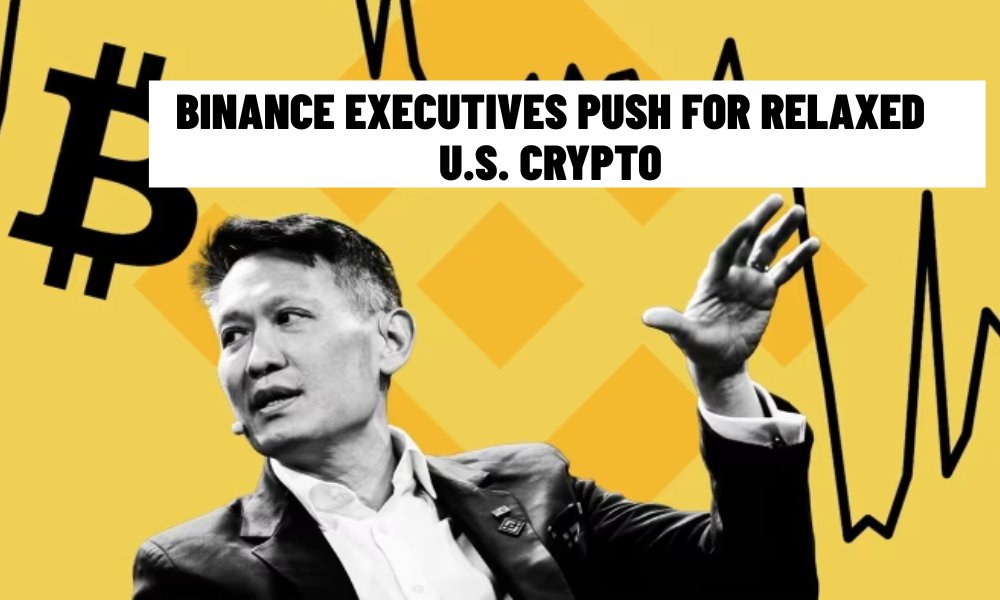On April 14, 2025, Binance, the world’s largest cryptocurrency exchange, made headlines when its executives met with U.S. Treasury Department officials to advocate for reduced government oversight of the crypto industry. The meeting, reported by The Wall Street Journal, reflects Binance’s bold push to reshape the regulatory landscape in the United States while exploring potential collaboration with World Liberty Financial (WLF), a Trump-backed crypto venture. This move underscores Binance’s strategic efforts to navigate a complex regulatory environment and capitalize on the evolving U.S. crypto market. Here’s an in-depth look at the implications, motivations, and potential outcomes of this development.
Binance’s Call for Regulatory Relief
Led by CEO Richard Teng and Chief Legal Officer Eleanor Hughes, Binance’s executives requested a significant rollback of government scrutiny, specifically targeting the oversight of their compliance with anti-money laundering (AML) regulations. The exchange sought to eliminate or narrow the scope of a court-appointed monitor installed to ensure adherence to U.S. laws following Binance’s 2023 guilty plea for AML violations. This monitor, a byproduct of a $4.3 billion settlement with the U.S. Department of Justice (DOJ), has been a point of contention for Binance, which views it as a costly and restrictive burden.

The push for reduced oversight comes as Binance aims to reposition itself in the U.S. market. The exchange’s former CEO, Changpeng Zhao, who stepped down as part of the 2023 settlement, has reportedly been quietly seeking a presidential pardon, signaling Binance’s intent to move past its legal troubles. The executives’ meeting with Treasury officials highlights a broader strategy to align with a more crypto-friendly U.S. administration under President Donald Trump, whose policies favor deregulation and blockchain innovation.
Exploring Ties with World Liberty Financial
A key element of the discussions was Binance’s interest in listing a new dollar-pegged cryptocurrency issued by World Liberty Financial (WLF) on its platform. WLF, a Trump-endorsed venture, aims to launch a stablecoin to compete in the rapidly growing digital asset market. By exploring this partnership, Binance is signaling its willingness to collaborate with politically connected crypto projects, potentially strengthening its influence in the U.S. The move also aligns with Binance’s global strategy of integrating innovative tokens to attract users and boost trading volume.
This potential collaboration reflects the shifting dynamics of the U.S. crypto industry, where political support for digital assets is gaining traction. Trump’s administration has proposed a Federal Strategic Bitcoin Reserve and signaled a lighter regulatory touch, creating an environment where exchanges like Binance see opportunities for growth. However, any deal with WLF would likely face scrutiny, given Binance’s history and the political sensitivities surrounding Trump-affiliated projects.
Regulatory Context: A Shifting Landscape
Binance’s request comes amid significant changes in U.S. crypto regulation. In April 2025, the DOJ announced the closure of its cryptocurrency crime unit, redirecting focus from broad crackdowns on exchanges to targeting individual fraud and scams. This shift, coupled with directives from Trump to agencies like the Securities and Exchange Commission (SEC) and Commodity Futures Trading Commission (CFTC) to scale back oversight, creates a more permissive environment for crypto firms.
The U.S. Congress is also prioritizing crypto legislation in 2025, with a focus on stablecoins and the Financial Innovation and Technology for the 21st Century Act (FIT21). These efforts aim to provide regulatory clarity, addressing long-standing industry demands for clear rules on taxation, AML, and know-your-customer (KYC) requirements. Binance’s advocacy for relaxed oversight aligns with this momentum, as the exchange seeks to operate with fewer constraints in a market poised for growth.
Binance’s Regulatory History and Challenges
Binance’s push for deregulation must be viewed in the context of its turbulent regulatory history. In 2023, the exchange faced allegations from U.S. authorities of facilitating illicit activities, including transactions linked to terrorist groups like Hamas. These accusations led to the DOJ’s massive fine and Zhao’s resignation. Additionally, Binance has faced criticism for its role in stablecoin markets, with some U.S. senators calling for investigations into its operations alongside Tether.
The detention of Binance executive Tigran Gambaryan in Nigeria since 2024 further complicates the exchange’s global image. Eighteen U.S. state attorneys general have urged President Biden to secure Gambaryan’s release, citing his contributions to Binance’s compliance efforts with U.S. laws. This situation underscores the delicate balance Binance must strike as it seeks to rebuild trust with regulators while advocating for less oversight.

Market Implications and Investor Sentiment
Binance’s efforts to ease U.S. oversight could have significant implications for the crypto market. A more lenient regulatory environment would lower compliance costs for exchanges, potentially spurring innovation and attracting institutional capital. The prospect of listing WLF’s stablecoin could also drive trading activity on Binance, reinforcing its dominance in the global market, where it holds $31 billion in stablecoin reserves.
Investor sentiment, as reflected on X, is mixed. Some users, like @Crypto_TownHall, view Binance’s move as a bullish signal for crypto adoption, citing the alignment with Trump’s pro-crypto policies. Others, including @WhaleWire, express skepticism, pointing to Binance’s regulatory baggage and the risks of politically charged partnerships. The market’s recent volatility, driven by Trump’s trade tariff announcements, adds uncertainty, though Bitcoin’s recovery to $84,000 suggests resilience among large investors, or “whales,” who are holding firm.
Risks and Headwinds
Binance’s push for relaxed oversight carries risks. Regulators may resist dismantling AML monitoring, given the exchange’s history of violations. Any partnership with WLF could draw scrutiny from lawmakers wary of conflicts of interest, especially amid reports of Binance negotiating business deals with the Trump family. Additionally, global regulatory trends, such as China’s tightened crypto transaction rules and South Korea’s stricter AML policies, contrast with the U.S.’s deregulatory shift, potentially complicating Binance’s operations in other markets.
The crypto market’s inherent volatility also poses challenges. A recent $370 billion market cap wipeout in February 2025, triggered by tariff fears, highlights the sensitivity of digital assets to macroeconomic policies. While Binance’s whale investors are showing patience, any misstep in its U.S. strategy could trigger sell-offs, impacting token prices and market confidence.
What’s Next for Binance and U.S. Crypto?
Binance’s advocacy for reduced oversight marks a pivotal moment for the U.S. crypto industry. If successful, the exchange could operate with greater flexibility, driving innovation in stablecoins, DeFi, and tokenized assets. The potential WLF partnership could further integrate crypto into mainstream finance, leveraging Trump’s political capital. However, Binance must navigate its regulatory history and global challenges to fully capitalize on this opportunity.
Key developments to watch include:
-
Regulatory Outcomes: Will the Treasury Department ease AML oversight, and how will Congress’s 2025 crypto laws shape Binance’s operations?
-
WLF Collaboration: Will Binance list WLF’s stablecoin, and what impact will this have on its U.S. market share?
-
Market Dynamics: Can Binance maintain investor confidence amid volatility, and will whale activity continue to support price stability?
For crypto investors and market observers, Binance’s bold move signals a new chapter in the U.S.’s crypto journey—one where deregulation, innovation, and political influence converge. As the industry awaits clarity, Binance’s actions will likely set the tone for how global exchanges engage with the world’s largest economy.
